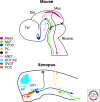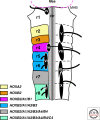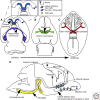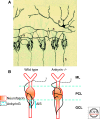Wiring the brain: the biology of neuronal guidance
- PMID: 20463002
- PMCID: PMC2869517
- DOI: 10.1101/cshperspect.a001917
Wiring the brain: the biology of neuronal guidance
Abstract
The mammalian brain is the most complex organ in the body. It controls all aspects of our bodily functions and interprets the world around us through our senses. It defines us as human beings through our memories and our ability to plan for the future. Crucial to all these functions is how the brain is wired in order to perform these tasks. The basic map of brain wiring occurs during embryonic and postnatal development through a series of precisely orchestrated developmental events regulated by specific molecular mechanisms. Below we review the most important features of mammalian brain wiring derived from work in both mammals and in nonmammalian species. These mechanisms are highly conserved throughout evolution, simply becoming more complex in the mammalian brain. This fascinating area of biology is uncovering the essence of what makes the mammalian brain able to perform the everyday tasks we take for granted, as well as those which give us the ability for extraordinary achievement.
Figures







References
-
- Alcamo EA, Chirivella L, Dautzenberg M, Dobreva G, Farinas I, Grosschedl R, McConnell SK 2008. Satb2 regulates callosal projection neuron identity in the developing cerebral cortex. Neuron 57:364–377 - PubMed
-
- Ango F, di Cristo G, Higashiyama H, Bennett V, Wu P, Huang ZJ 2004. Ankyrin-based subcellular gradient of neurofascin, an immunoglobulin family protein, directs GABAergic innervation at purkinje axon initial segment. Cell 119:257–272 - PubMed
Publication types
MeSH terms
LinkOut - more resources
Full Text Sources
Other Literature Sources
